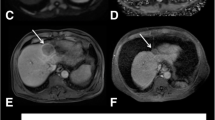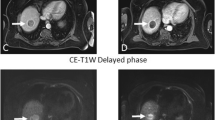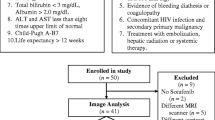Abstract
Aim: To compare changes in RECIST, anatomical volume, mRECIST, and volumetric diffusion-weighted Imaging parameters (3D apparent diffusion coefficient (ADC) measurements), with pathological analysis of hepatocellular carcinoma (HCC) treated by 90Yttrium radioembolization (Y90). Methods: 21 patients were treated by Y90 as a sole treatment modality for solitary, >2 cm HCC that underwent liver transplantation. MRI at baseline, 1 and 3 months post-Y90, and tumor pathological findings on explants were reviewed in all patients. Results: Compared to baseline (RECIST/volume: 3.6 cm/17.7 cm3), RECIST and volume were not modified after Y90 (1 month, p = 0.28/0.09 RECIST/tumor volume; 3 months, p = 0.28/0.54). In contrast, mRECIST (3.3–1.4 cm, p < 0.001), mean ADC (0.185–1.093 mm2/s × 10−3, p = 0.04), and ADC standard deviation (STD) (0.041–0.201 mm2/s × 10−3, p = 0.0496) changed as earlier as 1 month post-Y90. ADC STD % change was higher in ADC responding lesions than non-responding lesions at 1 month (p = 0.002) and 3 months (p = 0.008). All lesions exhibited necrosis on pathological analysis (11 partially viable, 10 complete pathological necrosis (CPN)) but no imaging criterion was able to predict CPN. mRECIST (±ADC) at 1 (κ ± ADC = 0.08/0.06) or 3 months (κ = −0.06/−0.06) were poor predictors of pathological response. Conclusion: As soon as 1 month post-treatment, mRECIST and volumetric ADC performed better than traditional size RECIST or volumetric parameters in detecting imaging response to Y90; however, CPN cannot be predicted by any criteria. Improvements in methodologies to assess response and identification of better surrogates are awaited.


Similar content being viewed by others
Abbreviations
- ADC:
-
Apparent diffusion coefficient
- cTACE:
-
Conventional transarterial chemoembolization
- CPN:
-
Complete pathological necrosis
- DWI:
-
Diffusion-weighted imaging
- GRE:
-
Gradient echo
- (m)RECIST:
-
(Modified) response criteria in solid tumors
- MRI:
-
Magnetic resonance imaging
- IQR:
-
Interquartile range
- 99Tc-MAA:
-
99Technetium-macroaggregated albumin
- STD:
-
Standard deviation
- Y90:
-
90Yttrium radioembolization
References
Eisenhauer EA, Therasse P, Bogaerts J, et al. (2009) New response evaluation criteria in solid tumours: revised RECIST guideline (version 1.1). Eur J Cancer 45(2):228–247. doi:10.1016/j.ejca.2008.10.026
Lencioni R, Llovet JM (2010) Modified RECIST (mRECIST) assessment for hepatocellular carcinoma. Seminars Liver Dis 30(1):52–60. doi:10.1055/s-0030-1247132
Riaz A, Kulik L, Lewandowski RJ, et al. (2009) Radiologic-pathologic correlation of hepatocellular carcinoma treated with internal radiation using yttrium-90 microspheres. Hepatology 49(4):1185–1193. doi:10.1002/hep.22747
Vouche M, Kulik L, Atassi R, et al. (2013) Radiological-pathological analysis of WHO, RECIST, EASL, mRECISTand DWI: imaging analysis from a prospective randomized trial of Y90±sorafenib. Hepatology 22(10):26487
El-Gazzaz G, Sourianarayanane A, Menon KV, et al. (2013) Radiologic-histological correlation of hepatocellular carcinoma treated via pre-liver transplant locoregional therapies. Hepatobiliary Pancreat Dis Int 12(1):34–41
Kamel IR, Reyes DK, Liapi E, Bluemke DA, Geschwind JF (2007) Functional MR imaging assessment of tumor response after 90Y microsphere treatment in patients with unresectable hepatocellular carcinoma. J Vasc Interv Radiol 18(1 Pt 1):49–56. doi:10.1016/j.jvir.2006.10.005
Rhee TK, Naik NK, Deng J, et al. (2008) Tumor response after yttrium-90 radioembolization for hepatocellular carcinoma: comparison of diffusion-weighted functional MR imaging with anatomic MR imaging. J Vasc Interv Radiol 19(8):1180–1186. doi:10.1016/j.jvir.2008.05.002
Lin M, Pellerin O, Bhagat N, et al. (2012) Quantitative and volumetric European Association for the Study of the Liver and Response Evaluation Criteria in Solid Tumors measurements: feasibility of a semiautomated software method to assess tumor response after transcatheter arterial chemoembolization. J Vasc Interv Radiol 23(12):1629–1637. doi:10.1016/j.jvir.2012.08.028
Yaghmai V, Miller FH, Rezai P, Benson AB 3rd, Salem R (2011) Response to treatment series: part 2, tumor response assessment–using new and conventional criteria. AJR Am J Roentgenol 197(1):18–27. doi:10.2214/ajr.11.6581
Halappa VG, Bonekamp S, Corona-Villalobos CP, et al. (2012) Intrahepatic cholangiocarcinoma treated with local-regional therapy: quantitative volumetric apparent diffusion coefficient maps for assessment of tumor response. Radiology 264(1):285–294. doi:10.1148/radiol.12112142
Gowdra Halappa V, Corona-Villalobos CP, Bonekamp S, et al. (2013) Neuroendocrine liver metastasis treated by using intraarterial therapy: volumetric functional imaging biomarkers of early tumor response and survival. Radiology 266(2):502–513. doi:10.1148/radiol.12120495
Li Z, Bonekamp S, Halappa VG, et al. (2012) Islet cell liver metastases: assessment of volumetric early response with functional MR imaging after transarterial chemoembolization. Radiology 264(1):97–109. doi:10.1148/radiol.12112161
Sherman M, Bruix J, Porayko M, Tran T (2012) Screening for hepatocellular carcinoma: the rationale for the American Association for the Study of Liver Diseases recommendations. Hepatology 56(3):793–796. doi:10.1002/hep.25869
Salem R, Thurston KG (2006) Radioembolization with 90Yttrium microspheres: a state-of-the-art brachytherapy treatment for primary and secondary liver malignancies: part 1: technical and methodologic considerations. J Vasc Interv Radiol 17(8):1251–1278
Kennedy A, Nag S, Salem R, et al. (2007) Recommendations for radioembolization of hepatic malignancies using yttrium-90 microsphere brachytherapy: a consensus panel report from the radioembolization brachytherapy oncology consortium. Int J Radiat Oncol Biol Phys 68(1):13–23. doi:10.1016/j.ijrobp.2006.11.060
Bonekamp S, Li Z, Geschwind JF, et al. (2013) Unresectable hepatocellular carcinoma: MR imaging after intraarterial therapy. Part I. Identification and validation of volumetric functional response criteria. Radiology 268(2):420–430. doi:10.1148/radiol.13122307
Corona-Villalobos CP, Pan L, Halappa VG, et al. (2013) Agreement and reproducibility of apparent diffusion coefficient measurements of dual-b-value and multi-b-value diffusion-weighted magnetic resonance imaging at 1.5 Tesla in phantom and in soft tissues of the abdomen. J Comput Assist Tomogr 37(1):46–51. doi:10.1097/RCT.0b013e3182720e07
Kritzinger J, Klass D, Ho S, et al. (2013) Hepatic embolotherapy in interventional oncology: technology, techniques, and applications. Clin Radiol 68(1):1–15. doi:10.1016/j.crad.2012.06.112
Kim YS, Lee WJ, Rhim H, et al. (2010) The minimal ablative margin of radiofrequency ablation of hepatocellular carcinoma (>2 and <5 cm) needed to prevent local tumor progression: 3D quantitative assessment using CT image fusion. AJR Am J Roentgenol 195(3):758–765. doi:10.2214/ajr.09.2954
Wang D, Gaba RC, ** B, et al. (2011) Intraprocedural transcatheter intra-arterial perfusion MRI as a predictor of tumor response to chemoembolization for hepatocellular carcinoma. Acad Radiol 18(7):828–836. doi:10.1016/j.acra.2011.02.016
Atassi B, Bangash AK, Bahrani A, et al. (2008) Multimodality imaging following 90Y radioembolization: a comprehensive review and pictorial essay. Radiographics 28(1):81–99. doi:10.1148/rg.281065721
Miller FH, Keppke AL, Reddy D, et al. (2007) Response of liver metastases after treatment with yttrium-90 microspheres: role of size, necrosis, and PET. AJR Am J Roentgenol 188(3):776–783. doi:10.2214/ajr.06.0707
Guo Y, Yaghmai V, Salem R, et al. (2013) Imaging tumor response following liver-directed intra-arterial therapy. Abdom Imaging 38(6):1286–1299. doi:10.1007/s00261-013-0017-5
Ibrahim SM, Nikolaidis P, Miller FH, et al. (2009) Radiologic findings following Y90 radioembolization for primary liver malignancies. Abdom Imaging 34(5):566–581. doi:10.1007/s00261-008-9454-y
Bonekamp D, Bonekamp S, Halappa VG, et al. (2014) Interobserver agreement of semi-automated and manual measurements of functional MRI metrics of treatment response in hepatocellular carcinoma. Eur J Radiol 83(3):487–496. doi:10.1016/j.ejrad.2013.11.016
Riaz A, Miller FH, Kulik LM, et al. (2010) Imaging response in the primary index lesion and clinical outcomes following transarterial locoregional therapy for hepatocellular carcinoma. JAMA 303(11):1062–1069. doi:10.1001/jama.2010.262
Mannelli L, Kim S, Hajdu CH, Babb JS, Taouli B (2013) Serial diffusion-weighted MRI in patients with hepatocellular carcinoma: prediction and assessment of response to transarterial chemoembolization. Preliminary experience. Eur J Radiol 82(4):577–582. doi:10.1016/j.ejrad.2012.11.026
Mannelli L, Kim S, Hajdu CH, et al. (2009) Assessment of tumor necrosis of hepatocellular carcinoma after chemoembolization: diffusion-weighted and contrast-enhanced MRI with histopathologic correlation of the explanted liver. AJR Am J Roentgenol 193(4):1044–1052. doi:10.2214/ajr.08.1461
Kim S, Mannelli L, Hajdu CH, et al. (2010) Hepatocellular carcinoma: assessment of response to transarterial chemoembolization with image subtraction. J Magn Reson Imaging 31(2):348–355. doi:10.1002/jmri.22038
Duke E, Deng J, Ibrahim SM, et al. (2010) Agreement between competing imaging measures of response of hepatocellular carcinoma to yttrium-90 radioembolization. J Vasc Interv Radiol 21(4):515–521. doi:10.1016/j.jvir.2009.11.020
Walrand S, Hesse M, Chiesa C, Lhommel R, Jamar F (2014) The low hepatic toxicity per Gray of 90Y glass microspheres is linked to their transport in the arterial tree favoring a nonuniform trap** as observed in posttherapy PET imaging. J Nucl Med 55(1):135–140. doi:10.2967/jnumed.113.126839
Yokoyama T, Yoshida H, Hirakata A, et al. (2012) Spontaneous complete necrosis of advanced hepatocellular carcinoma. J Nippon Med Sch 79(3):213–217
Sasaki T, Fukumori D, Yamamoto K, et al. (2013) Management considerations for purported spontaneous regression of hepatocellular carcinoma: a case report. Case Reports Gastroenterol 7(1):147–152. doi:10.1159/000350501
Brown DB, Gould JE, Gervais DA, et al. (2009) Transcatheter therapy for hepatic malignancy: standardization of terminology and reporting criteria. J Vasc Interv Radiol 20(7 Suppl):S425–S434. doi:10.1016/j.jvir.2009.04.021
Cho YK, Kim Y, Rhim H (2009) Pitfalls in the radiological and pathological correlation of tumour response rates of hepatocellular carcinoma following radiofrequency ablation. J Clin Pathol 62(12):1071–1073. doi:10.1136/jcp.2009.069716
Acknowledgment
There was no funding provided for this study.
Conflict of interest
None of the other authors have any conflict of interest.
Author information
Authors and Affiliations
Corresponding author
Rights and permissions
About this article
Cite this article
Vouche, M., Salem, R., Lewandowski, R.J. et al. Can volumetric ADC measurement help predict response to Y90 radioembolization in HCC?. Abdom Imaging 40, 1471–1480 (2015). https://doi.org/10.1007/s00261-014-0295-6
Published:
Issue Date:
DOI: https://doi.org/10.1007/s00261-014-0295-6




